The Anti-Slavery Movement and the Underground Railroad
by James F. Caccamo
Colonial:
 First importation of Africans in British North America was in 1619 at Jamestown, Virginia. (Africans were in French North America by 1606). Massachusetts allowed chattel slavery in 1641. Chattel slavery was legally recognized in British North America 1650 although not actively practiced in all colonies.
First importation of Africans in British North America was in 1619 at Jamestown, Virginia. (Africans were in French North America by 1606). Massachusetts allowed chattel slavery in 1641. Chattel slavery was legally recognized in British North America 1650 although not actively practiced in all colonies.
 In 1672, the British crown endorsed the slave trade and created the Royal African Company to expedite it.
In 1672, the British crown endorsed the slave trade and created the Royal African Company to expedite it.
 In 1750, Georgia permitted slavery, the last of the original colonies to do so.
In 1750, Georgia permitted slavery, the last of the original colonies to do so.
 Rhode Island abolished slavery within its borders 1774.
Rhode Island abolished slavery within its borders 1774.
 Slavery was abolished 1777 in Vermont and 1780 in Massachusetts. In 1780, gradual emancipation was started in Pennsylvania. Other states to abolish slavery were New Hampshire in 1783, Connecticut in 1784, and New York in 1799. New Jersey instituted gradual emancipation in 1804. Slavery was outlawed in the Northwest Territory in 1787.
Slavery was abolished 1777 in Vermont and 1780 in Massachusetts. In 1780, gradual emancipation was started in Pennsylvania. Other states to abolish slavery were New Hampshire in 1783, Connecticut in 1784, and New York in 1799. New Jersey instituted gradual emancipation in 1804. Slavery was outlawed in the Northwest Territory in 1787.
National:
 The Ordinance of 1787 (Northwest Ordinance) required returning of runaways in the territory.
The Ordinance of 1787 (Northwest Ordinance) required returning of runaways in the territory.
 The U.S. Constitution (1788) provided for return of fugitive slaves in Article 4, Section 3.
The U.S. Constitution (1788) provided for return of fugitive slaves in Article 4, Section 3.
 In 1790 Quakers began lobbying Congress to abolish slavery. No action was taken by Congress.
In 1790 Quakers began lobbying Congress to abolish slavery. No action was taken by Congress.
 The first federal Fugitive Slave Law was enacted in 1793. It gave slave owners the right to pursue and capture slaves and provided for a $500 fine for those helping runaways. In that same year, Upper Canada (present Ontario) abolished slavery within its borders.
The first federal Fugitive Slave Law was enacted in 1793. It gave slave owners the right to pursue and capture slaves and provided for a $500 fine for those helping runaways. In that same year, Upper Canada (present Ontario) abolished slavery within its borders.
 France abolishes slavery in all its territories in 1794.(Napoleon re-institutes slavery in 1802.)
France abolishes slavery in all its territories in 1794.(Napoleon re-institutes slavery in 1802.)
 In 1808, Congress banned the African slave trade. The law was frequently broken. An estimated quarter of a million Africans were illegally imported as slaves between 1808 and 1865.
In 1808, Congress banned the African slave trade. The law was frequently broken. An estimated quarter of a million Africans were illegally imported as slaves between 1808 and 1865.
 Mexico abolished slavery in 1829, but allowed slavery to continue in its Texas colony.
Mexico abolished slavery in 1829, but allowed slavery to continue in its Texas colony.
 The 1820 Missouri Compromise allowed Missouri to be a slave state but kept slavery out of the north.
The 1820 Missouri Compromise allowed Missouri to be a slave state but kept slavery out of the north.
 In 1831 William Lloyd Garrison sparked the Abolitionist movement when he began publishing the Liberator. Also in 1831, Nat Turnerís rebellion took place.
In 1831 William Lloyd Garrison sparked the Abolitionist movement when he began publishing the Liberator. Also in 1831, Nat Turnerís rebellion took place.
 In 1832 In the aftermath of the Liberator, fervent Abolitionists attacked the position of the American Colonization Society. The controversy was particularly heated in Ohio.
In 1832 In the aftermath of the Liberator, fervent Abolitionists attacked the position of the American Colonization Society. The controversy was particularly heated in Ohio.
 Slavery was abolished throughout the British Empire, including Canada, in 1833.
Slavery was abolished throughout the British Empire, including Canada, in 1833.
 In 1842 the United States Supreme Court ruled in Prigg vs. Pennsylvania that "free" states couldnít pass laws negating federal fugitive slave laws within their borders.
In 1842 the United States Supreme Court ruled in Prigg vs. Pennsylvania that "free" states couldnít pass laws negating federal fugitive slave laws within their borders.
 The Fugitive Recovery Bill of 1850 forced legal officials to assist claimants or face a $1000 fine, forbade slaves to testify in court on their own behalf, allowed claimants to take any black into slavery as long as there was an affidavit issued by any judge or magistrate, and levied a 6 month jail sentence, a $1000 fine and up to $1000 in civil damages against anyone assisting a slave. California was admitted as a free state and slavery was abolished in the District of Columbia. The western territories were left open to slavery.
The Fugitive Recovery Bill of 1850 forced legal officials to assist claimants or face a $1000 fine, forbade slaves to testify in court on their own behalf, allowed claimants to take any black into slavery as long as there was an affidavit issued by any judge or magistrate, and levied a 6 month jail sentence, a $1000 fine and up to $1000 in civil damages against anyone assisting a slave. California was admitted as a free state and slavery was abolished in the District of Columbia. The western territories were left open to slavery.
 The 1854 Kansas-Nebraska Act left issue of slavery in new states up to popular sovereignty. In fact, though, it produced a civil war, called "Bleeding Kansas", where pro-slavery and anti-slavery forces engaged in vigilante activities.
The 1854 Kansas-Nebraska Act left issue of slavery in new states up to popular sovereignty. In fact, though, it produced a civil war, called "Bleeding Kansas", where pro-slavery and anti-slavery forces engaged in vigilante activities.
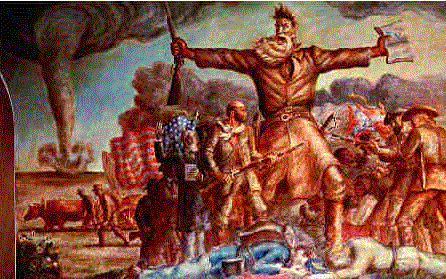
John Brown in Kansas
 In 1857, the United State Supreme Courtís Dred Scott Decision (Scott vs. Sandford) nullified anti-slavery advocatesí right to enforce "free" laws in their territories. It also stated that a slave did not become free by entering a free state, that the federal government could not bar slavery from any territory, and that blacks were not and could not be citizens of the United States.
In 1857, the United State Supreme Courtís Dred Scott Decision (Scott vs. Sandford) nullified anti-slavery advocatesí right to enforce "free" laws in their territories. It also stated that a slave did not become free by entering a free state, that the federal government could not bar slavery from any territory, and that blacks were not and could not be citizens of the United States.
 In a rescue of a fugitive slave who had been captured in Oberlin and taken to Wellington, Ohio, 37 individuals are indicted for violating the Fugitive Recovery Bill of 1850.
In a rescue of a fugitive slave who had been captured in Oberlin and taken to Wellington, Ohio, 37 individuals are indicted for violating the Fugitive Recovery Bill of 1850.
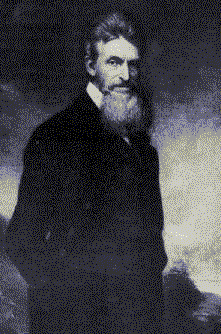
John Brown
 John Brown, a former resident of Franklin Mills, raided Harpers Ferry on October 16, 1859; Brown was executed on December 2.
John Brown, a former resident of Franklin Mills, raided Harpers Ferry on October 16, 1859; Brown was executed on December 2.
 In November 1860 Abraham Lincoln was elected President.
South Carolina seceded from the Union on December 24, 1860. Ft. Sumter was attacked on April 12, 1861.
In November 1860 Abraham Lincoln was elected President.
South Carolina seceded from the Union on December 24, 1860. Ft. Sumter was attacked on April 12, 1861.
 Abraham Lincoln issued the Emancipation Proclamation Sept. 22, 1862, effective January 1, 1863 which affected only seceded states (not Kentucky, West Virginia, Maryland, Missouri, or Delaware).
Abraham Lincoln issued the Emancipation Proclamation Sept. 22, 1862, effective January 1, 1863 which affected only seceded states (not Kentucky, West Virginia, Maryland, Missouri, or Delaware).
 The13th Amendment to the Constitution abolished all slavery in the United States December 18, 1865.
The 14th Amendment granted blacks citizenship July 28, 1868.
The 15th Amendment gave blacks the vote March 30, 1870.
The13th Amendment to the Constitution abolished all slavery in the United States December 18, 1865.
The 14th Amendment granted blacks citizenship July 28, 1868.
The 15th Amendment gave blacks the vote March 30, 1870.
In Ohio:
 In 1803 the first constitution of the state prohibited slavery within its borders.
In 1803 the first constitution of the state prohibited slavery within its borders.
 On January 5, 1804 , Ohio passed the first "Black Laws". All blacks in Ohio had to obtain a Certificate of Freedom by June of 1804. It had to be renewed every two years. $50 in fines were levied against those who hired blacks without certificates. There was a $1000 fine for helping runaways escape.
On January 5, 1804 , Ohio passed the first "Black Laws". All blacks in Ohio had to obtain a Certificate of Freedom by June of 1804. It had to be renewed every two years. $50 in fines were levied against those who hired blacks without certificates. There was a $1000 fine for helping runaways escape.
 A January 25, 1807 law said blacks had to pay a $500 per head bond for a certificate of freedom or leave the state within 20 days. $100 was added on to the fine of those helping runaways. Blacks were not permitted to testify in any trial involving whites, nor could they sue whites. Blacks and persons of mixed ancestry were forbidden to marry whites. Both the 1804 and 1807 laws prohibited black children from attending public school (These laws were repealed in 1849).
A January 25, 1807 law said blacks had to pay a $500 per head bond for a certificate of freedom or leave the state within 20 days. $100 was added on to the fine of those helping runaways. Blacks were not permitted to testify in any trial involving whites, nor could they sue whites. Blacks and persons of mixed ancestry were forbidden to marry whites. Both the 1804 and 1807 laws prohibited black children from attending public school (These laws were repealed in 1849).
 In the summer of 1832, Western Reserve College in Hudson, Ohio was torn asunder by the Abolition versus Colonization debate.
In the summer of 1832, Western Reserve College in Hudson, Ohio was torn asunder by the Abolition versus Colonization debate.
 The first state anti-slavery convention was in Putnam, Ohio near Zanesville in Muskingum County, April 23-24, 1835. Portage County's representatives included Asahel Kilborn from Hudson and Philo Wright from Tallmadge.
The first state anti-slavery convention was in Putnam, Ohio near Zanesville in Muskingum County, April 23-24, 1835. Portage County's representatives included Asahel Kilborn from Hudson and Philo Wright from Tallmadge.
 On February 28, 1839, Ohio passed new laws which levied a $500 fine for helping fugitive slaves with a prison term of up to 60 days. The law allowed any black to be taken into custody based on a warrant issued by any judge, justice of the peace, or mayor.
On February 28, 1839, Ohio passed new laws which levied a $500 fine for helping fugitive slaves with a prison term of up to 60 days. The law allowed any black to be taken into custody based on a warrant issued by any judge, justice of the peace, or mayor.
 During the 1848-1849 legislative season, the Ohio House debated seceding from the Union in protest over continued slavery in the south.
During the 1848-1849 legislative season, the Ohio House debated seceding from the Union in protest over continued slavery in the south.
 Separate schools for blacks were mandated in Ohio in 1853.
A new law in 1861 prohibited interracial marriages again.
These two "Black Laws" werenít repealed until 1887.
Separate schools for blacks were mandated in Ohio in 1853.
A new law in 1861 prohibited interracial marriages again.
These two "Black Laws" werenít repealed until 1887.
 Blacks in Ohio were prohibited from voting until 1870, when the 15th Amendment to the Constitution was adopted.
Blacks in Ohio were prohibited from voting until 1870, when the 15th Amendment to the Constitution was adopted.
Quotes about the UGRR in Northeast Ohio:
 In the summer of 1825, a group of fugitive slaves showed up at the Woodard Tavern in Franklin Mills (now Kent) that stood on the southwest corner of Fairchild Road and Mantua Street. Joshua Woodard hid the family, fed them, and in the morning arranged for his son, James, to load them in a wagon and drive them north. The party left behind a small boy, whom Mrs. Woodard raised.
In the summer of 1825, a group of fugitive slaves showed up at the Woodard Tavern in Franklin Mills (now Kent) that stood on the southwest corner of Fairchild Road and Mantua Street. Joshua Woodard hid the family, fed them, and in the morning arranged for his son, James, to load them in a wagon and drive them north. The party left behind a small boy, whom Mrs. Woodard raised.
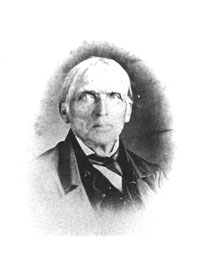
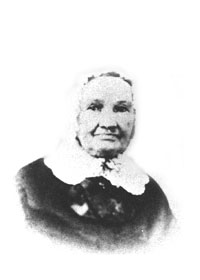

Joshua, Rebecca, and James Woodard
 David Hudson, Jr. writes in his diary: "Two men came this evening in a sleigh, bringing a Negro woman, a runaway slave, and her two children." to the David Hudson House, Hudson, Ohio January 5, 1826.
David Hudson, Jr. writes in his diary: "Two men came this evening in a sleigh, bringing a Negro woman, a runaway slave, and her two children." to the David Hudson House, Hudson, Ohio January 5, 1826.
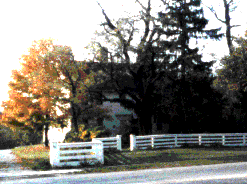
David Hudson House
 John Buss writes in his diary "A runaway slave, his wife, and child..." arrived on the Western Reserve College campus (in Hudson) November 11, 1834. The boys at the college scraped up $5.00 to send the family on to Cleveland.
John Buss writes in his diary "A runaway slave, his wife, and child..." arrived on the Western Reserve College campus (in Hudson) November 11, 1834. The boys at the college scraped up $5.00 to send the family on to Cleveland.

Old Western Reserve College, Hudson
 Lora Case writes in "It was a rare thing that a passenger attempted it [the Underground Railroad] or got through on our road." July 1859. Case's station was between Hudson and Streetsboro on State Route 303.
Lora Case writes in "It was a rare thing that a passenger attempted it [the Underground Railroad] or got through on our road." July 1859. Case's station was between Hudson and Streetsboro on State Route 303.
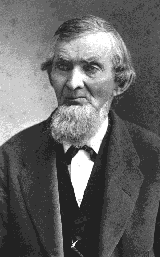
Lora Case
 To the west is the farmhouse in which John Brown's brother, Jeremiah Root Brown, ran a station and where the guns for the Harpers Ferry raid were stored.
To the west is the farmhouse in which John Brown's brother, Jeremiah Root Brown, ran a station and where the guns for the Harpers Ferry raid were stored.
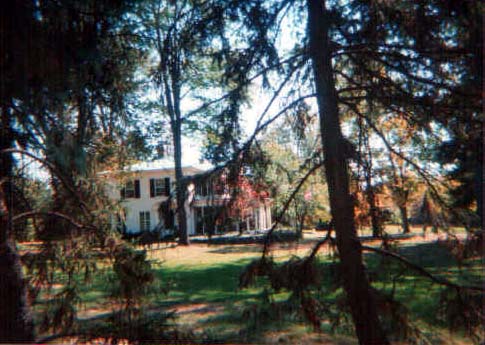
Jeremiah Root Brown House, Hudson
Click HERE to view more Summit County Sites
 In Franklin Mills, at the old Cuyahoga House where Diggers Restaurant now stands on Mantua Street, Jonathan and Eliza James hid slaves in a hollowed-out section of the barn wall.
In Franklin Mills, at the old Cuyahoga House where Diggers Restaurant now stands on Mantua Street, Jonathan and Eliza James hid slaves in a hollowed-out section of the barn wall.

The Cuyahoga House, a Station on the Underground Railroad
Click HERE to view more Portage County Sites.
To the south of the Western Reserve area, the main helpers on the Underground Railroad were Quakers. A good example of one of their stations on the Underground Railroad is Spring Hill in Massillon, Stark County. It was the home of Thomas and Charity Rotch who were prominent Stark County Quakers.

Spring Hill
Click HERE to view more Stark County Sites
Click HERE if you are interested in Medina County.
Click HERE if you are interested in Wayne County.
Return to the Kent Historical Society Home Page
Learn More About John Brown
Click Here to Visit Sites in Selected Northeast Ohio Counties
Click Here to View an Underground Railroad Case History for Hudson, Ohio
 Click here to find out how to join the Kent Historical Society and support this website.
Click here to find out how to join the Kent Historical Society and support this website.

Sign Guestbook
View Guestbook
© 2000-2003 The Kent Historical Society. Send mail to: contactus@kenthist.org
This page hosted by  Get your own Free Home Page
Get your own Free Home Page
 First importation of Africans in British North America was in 1619 at Jamestown, Virginia. (Africans were in French North America by 1606). Massachusetts allowed chattel slavery in 1641. Chattel slavery was legally recognized in British North America 1650 although not actively practiced in all colonies.
First importation of Africans in British North America was in 1619 at Jamestown, Virginia. (Africans were in French North America by 1606). Massachusetts allowed chattel slavery in 1641. Chattel slavery was legally recognized in British North America 1650 although not actively practiced in all colonies.
 The Ordinance of 1787 (Northwest Ordinance) required returning of runaways in the territory.
The Ordinance of 1787 (Northwest Ordinance) required returning of runaways in the territory.


 In 1803 the first constitution of the state prohibited slavery within its borders.
In 1803 the first constitution of the state prohibited slavery within its borders.
 In the summer of 1825, a group of fugitive slaves showed up at the Woodard Tavern in Franklin Mills (now Kent) that stood on the southwest corner of Fairchild Road and Mantua Street. Joshua Woodard hid the family, fed them, and in the morning arranged for his son, James, to load them in a wagon and drive them north. The party left behind a small boy, whom Mrs. Woodard raised.
In the summer of 1825, a group of fugitive slaves showed up at the Woodard Tavern in Franklin Mills (now Kent) that stood on the southwest corner of Fairchild Road and Mantua Street. Joshua Woodard hid the family, fed them, and in the morning arranged for his son, James, to load them in a wagon and drive them north. The party left behind a small boy, whom Mrs. Woodard raised.







